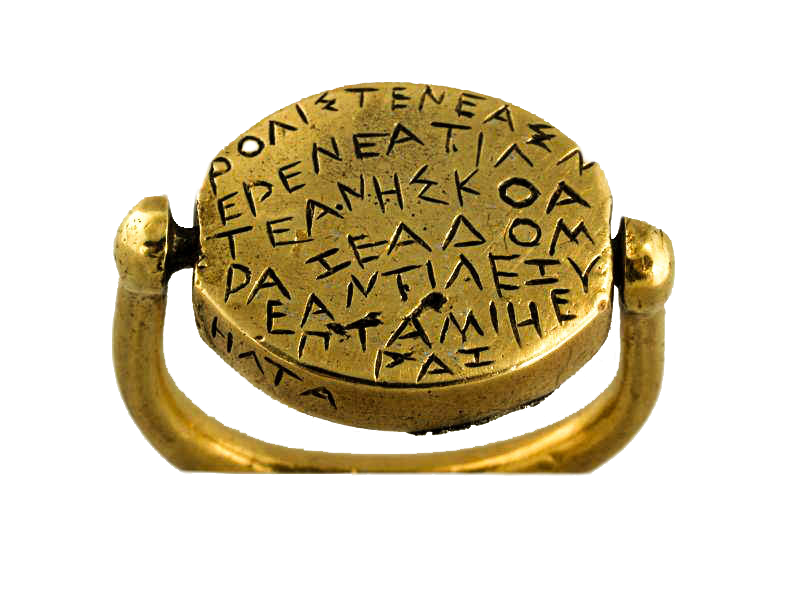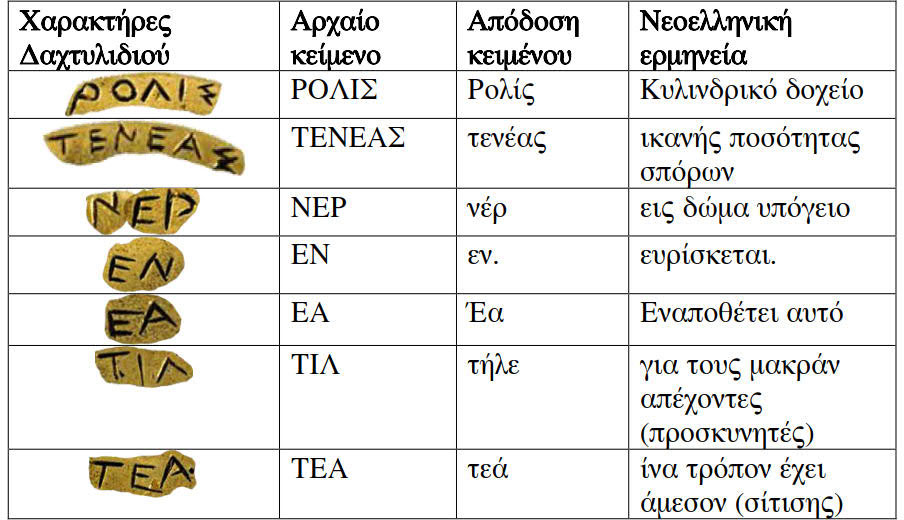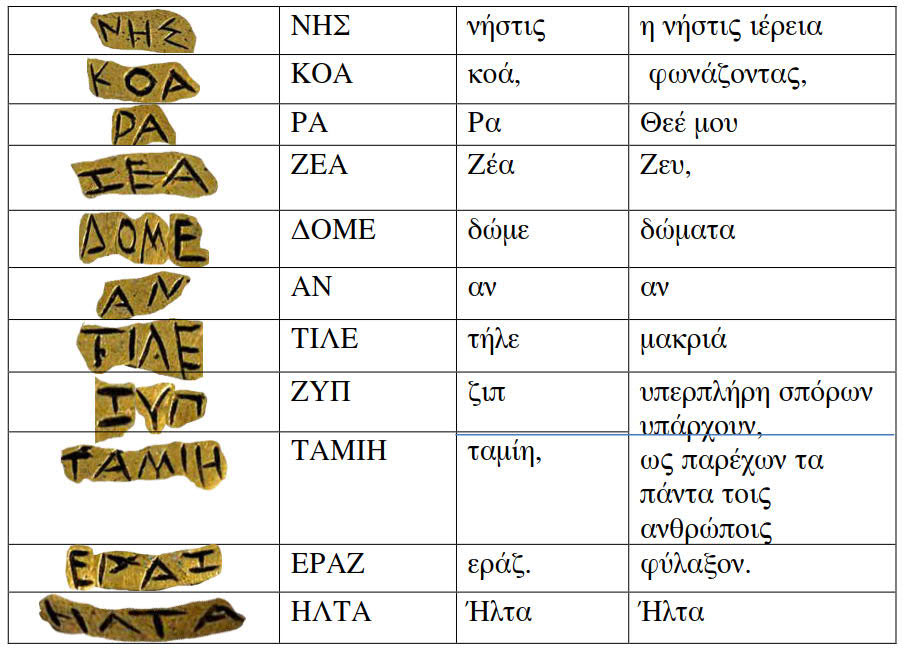THE RING OF EZEROVO- BULGARIA
The carvings on the sling of the ring are a prayer to Zeus.
Its History
In the wider area of Agrianes, in the Thracian land, a part of which is nowadays under the mastery of Bulgaria, there is a village in the north-eastern part of Ormenio, its modern name of which is Ezerovo, and it belongs to the administrative area of Vonisogratz, between the towns of Haskovo and Plovdiv. In 1912, the excavations in the area, revealed a grand grave. The dead person into the grave, who may have been a famous personality of the time, had, apart from other crafts into the grave, a golden ring in his finger. This ring had 60 letters of the Greek Alphabet, carved on its surface. It is an important evidence, as it witnesses the Thracian written and spoken discourse. For the Thracians, written discourse was considered a shame.
*** The carvings on the sling of the ring are a prayer to Zeus.***
A Multiple Approach
During the excavation, this dead person was found wearing this important discovery in his hand. And it was important, as the written discourse recorded on it was an evidence of the Thracian discourse in the second half of the 5th century B.C., approximately in 403 B.C.. The dead person, a famous personality of the land of Pomaks of Old Sapes, through this ring offered his best as a written evidence of the discourse Agrianes, on the Rhodope Mountains, used.
I am certainly not the first person to have worked, in order to identify the words, as well as to render the meaning of the words on the sling of the ring. Before me, I think there were 27 researchers who dealt with the issue, and they came from Europe, the Balkans and Greece. The inscription is an evidence of the Greek language undoubtedly. Each one forms the text of the inscription according to his/her concept. Of course, this can be understood and it is allowed by the text itself, as there are words of the first Greek language that include only their base form, with no suffix. This was essential for researchers, who had to approach a lot of texts of the time, which were of a similar type.
A Scientific Approach
The carvings of the ring belong to the category of the written discourse with capital letters.
During this era, there was not any distinction between the capital and the small letters, as this happens nowadays. There is a small carving over the word “ΤΑΜΙΗ”, but this is not rendered in meaning. These 60 letters are shared in 7 lines, and their writing direction is from left to right. In my opinion, in the boustrophedon writing system, a text cannot be phonetically transcribed. And this is the way I have tried to approach the text, during my research. I rejected it however, because, according to my own criteria, it was utopian.
The text is phonetic and not orthographical, so the vowels do not have an orthographical identity in the text. One can read Doric and Ancient Minoan words, that nowadays are only found in the Pontic Dialect. I believe that the Thracians, as well as the Macedonians, always used the dense consonants. This is also evident in the Thracian Dialect of today.
As I have already said, 27 different interpretations have been testified so far. I disagree with the majority of them. Through the present study, I express my own opinion to be judged and used.
Moreover, I do not file a text for a simple reading. At first, I single the words out, and I use marks, according to the meaning. The phonetic transcription completes the meaning and the Modern Greek interpretation rounds up the whole project. However, my thesis is accompanied by a detailed analysis and a reference of all the words that came from discourse composition. This procedure has not been seen in any detailed study, and it gives me the right to state that my own approach is the most thorough and it proves the truth, using the Greek discourse and its older forms as a background.

Development of the Text:
ΡΟΛΙΣΤΕΝΕΑΣΝΕΡΕΝΕΑΤΙΛΤΕΑΝΗΣΚΟΑΡΑΖΕΑΔΟΜΕΑΝΤΙΛΕΖΥΠΤΑΜΙΗΕΡΑΖ ΗΛΤΑ
ΡΟΛΙΣ ΤΕΝΕΑΣ ΝΕΡ ΕΝ. ΕΑ ΤΙΛ ΤΕΑ ΝΗΣ ΚΟΑ, ΡΑ ΖΕΑ ΔΟΜΕ ΑΝ ΤΙΛΕ ΖΥΠ ΤΑΜΙΗ, ΕΡΑΖ. ΗΛΤΑ


Identification of the words of the Text:
ΡΟΛΙΣ ΤΕΝΕΑΣ ΝΕΡ ΕΝ. ΕΑ ΤΙΛ ΤΕΑ ΝΗΣ ΚΟΑ. ΡΑ ΖΕΑ, ΔΟΜΕ ΑΝ ΤΙΛΕ ΖΥΠ ΤΑΜΙΗ, ΕΡΑΖ. ΗΛΤΑ
Rendition of the Text:
Ρολίς τενέας νέρ εν. Έα Τίλλε τεά νήστις κοά, Ρα Ζέα δόμε αν τίλε ζυπ ταμίει, εράζ. Ήλτα
The Text in Modern Greek:
A cylindrical pot with plenty of seeds in a cellar. The priestess puts this pot in the cellar for the pilgrims fasting for a long time, in order to find some food, and she shouts: “Zeus, if there are rooms full of seeds, take care of them, as You are everyone’s Lord”. Ilta.
(Κυλινδρικό δοχείο ικανής ποσότητας σπόρων εις δώμα υπόγειο ευρίσκεται. Εναποθέτει αυτό για τους μακράν απέχοντες (προσκυνητές) ίνα τρόπον έχει άμεσον (σίτισης) η νήστις ιέρεια φωνάζοντας, Θεέ μου Ζευ, δώματα αν μακριά υπερπλήρη σπόρων υπάρχουν, ως παρέχων τα πάντα τοις ανθρώποις φύλαξον. Ήλτα)
A Philosophical Approach and an Analysis of the Text
One can draw some conclusions after the reading of the text:
First of all, the Thracians of the time when the ring was carved, had a religion. As Greeks, they believed in the Olympian Gods. A part of this text is a prayer to Zeus, whose title is “Zeus Treasurer” (“Ζεύς Ταμίης”) (Treasurer is the God who provides everything to the people). This is a quality that our ancestors used to attribute to the Chief God. We find this title in other subsequent texts about crop festivals.
The products are gods’ provisions and then, they are offered as gifts to the farmers. The crops had often been destroyed by ice, strong hail, insects or other physical phenomena. This is the reason why God’s protection is needed and the worshippers of every religious dogma find a shelter in it through time. Almost always an act of God is considered a punishment for irreverence and injustice that at least those in power project. About not honouring the gods, not obeying them, the people’s arrogance to the gods and to the weak losers.
It is time to narrate a very old Macedonian myth about it. Karanos, the first king of Elleimeia, who was also the husband of beautiful Kaliani, falls out with his neighbours in Eordaia, he wins them and he slaughters 600 of them. The people from Elleimeia cut the dead losers’ heads and as a trophy, they pierce the ground with their lances and put these heads on those lances. When Zeus realized this unholy and humiliating act, he was transformed to a lion, he rushed and he dilapidated all the lances, breaking down a few unholy fighters. Since then this act against the dead has not taken place as a show of power, for fear that God will punish it.Αlas! Those punished by Gods wander like Achaeans, as nowadays we falsely consider them to be.
Is the author the dead person?
From the findings in the grave, we can conclude that the dead person was a famous personality.
As a result, the carvings may have been an order by him to a carver of the time.
If so, what does the name Ilta, carved on the one side of the grave, represent?
She may have been a priestess or the dead person’s wife. It is certain that the dead person has a relationship with the sacred element, either as a Religious leader or as a main donor and worshipper.
Another version, is that the inscription on the ring is a religious saying.
The priestess named Ilta manages the wealth. She saves some seeds to prepare a meal after the church service for the visitors coming from other places. At the same time, however, she prays to Treasurer Zeus to protect all goods, even in remote areas. Of course, she hopes that the owners will bring some tanea (a Pontic soup) as a feature to the God.
Moreover, in Minoan Crete, most of the plaques in sanctuaries include references to tanea/tenea, that the worshippers used to bring. Her prayer to God for protection of all the wealth in the world, belongs to the people mainly, and subsequently to its owner. Maybe this dead person was a rich worshipper in the sanctuary where Ilta functioned as a priestess, and this ring may have been a gift of the sanctuary to the donor. Another version is that the dead person may have been a Religious leader, and this ring is a proof of Ilta’s dogma.
The text is a part of Ilta’s ritual saying towards Zeus. For this reason, the priestess is crying out: Zeus, if there are enough seeds in remote places, protect them. (Θεέ μου Ζευ, δώματα αν μακριά υπερπλήρη σπόρων υπάρχουν, ως παρέχων τα πάντα τοις ανθρώποις φύλαξον). Α prayer to the God, 2500 years ago, by the Priestess of the time, which is similar to a present one and up to the minute. We may conclude that there is no change in the Greek customs and rituals across time.
